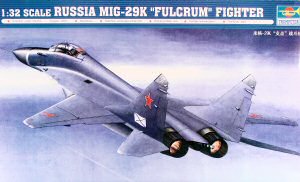
Trumpeter 1/32 MiG-29K Fulcrum Kit First Look
By Michael Benolkin
| Date of Review | February 2007 | Manufacturer | Trumpeter |
|---|---|---|---|
| Subject | MiG-29K Fulcrum | Scale | 1/32 |
| Kit Number | 2239 | Primary Media | Photo-Etch, White Metal, Styrene |
| Pros | Excellent scribed detailing throughout | Cons | No provision to fold the wings |
| Skill Level | Intermediate | MSRP (USD) | $139.95 |
First Look
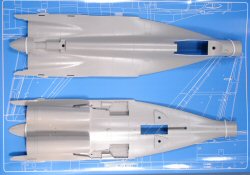 |
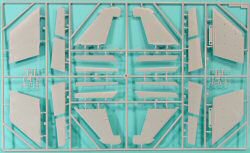 |
 |
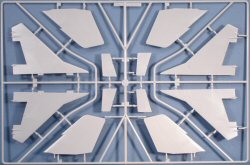 |
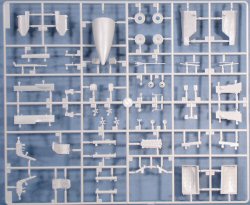 |
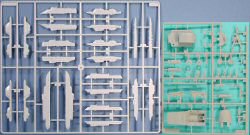 |
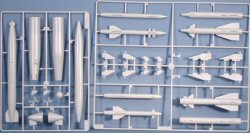 |
 |
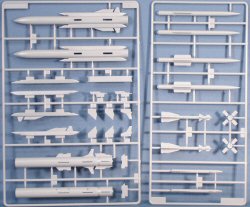 |
 |
 |
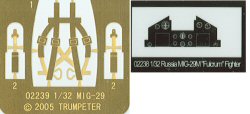 |
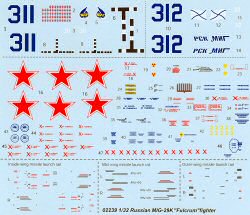 |
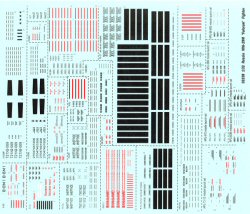 |
The MiG-29K was the MiG OKB's response to a requirement to equip the Soviet Union's first conventional take-off and landing aircraft carriers. Alongside variants of the Su-27 Flanker and Su-25 Frogfoot, the MiG-29K would be the MiG OKB's only successfuly entry to reach sea trials.
Developed in parallel with the MiG-29M, these two fighters were intended to serve and the next generation of land fighter as well as the first generation of carrier-based fighter. While the MiG-29K was leading the competition against the Su-27K, the first prototype was damaged at a critical time in the program and the carrier literally set sail without the MiG-29K aboard. The collapse of the Soviet Union, the lack of funding for Russian carrier aviation, and only one carrier in service left the MiG-29K in the same position as the MiG-29M - no customers.
The good news for the MiG OKB was the recent signing of an agreement between India and Russia which would equip the Indian Navy's aircraft carrier with MiG-29Ks. With India as a launch customer for this aircraft and the warming interest within the Russian military, the MiG-29K may have a second chance for service.
I was impressed with the first release of this kit, the MiG-29M (reviewed here) when it came out over a year ago. What surprised me was how quietly this second version came out as I'd been interested in the naval Fulcrum kit since it was first announced. Now that I have the kit in hand, I can see why someone might overlook this kit - it is nearly identical to the MiG-29M release with the exception of two parts trees and the decal sheet. But what a difference those two trees make! (The images to the right are all the same from the MiG-29M review with the exception of the two new trees and the new decal sheet.)
Molded in light gray styrene, the kit consists of over 850 parts (!!!) and is presented on 15 parts trees (duplicate trees not shown) along with separate upper and lower fuselage halves, four engine nozzle parts, plus three small trees containing the clear parts. In addition, the kit features two frets of photo-etch, rubber tires, and white metal landing gear struts.
At first glance, the cockpit tub looks rather plain, but when you look at all of the stuff that goes in there as separate parts, this cockpit is going to look awesome. The cockpit tub is different from the one provided in the MiG-29M kit as it has a standard stick between the legs rather than the side-stick, and the rest of the cockpit layout is also nicely captured.
The K-36D ejection seat is beautifully rendered, right down to the complex ejection seat harness that is captured on one of the two photo-etch frets. Eduard has since released a color photo-etch set for the complex harness used on the K-36D and it does make the job of detailing the seat much easier.
The kit's wings are a bit of a mystery to me. Trumpeter provided the inboard and outboard sections of the wing separately, and captured the fairings on the wing joint to replicate the wing fold mechanism. This is fine, but Trumpeter didn't provide any parts to actually fold the wings! The only parts present are intented to keep the wings in flight position. Then there are those photo-etched flight control hinges that I really don't care for, but at least the photo-etched hinges are easily dealt with.
The wings are mounted to the lower fuselage half with two screws each, but little mechanical reinforcement otherwise. I am not at all happy with this arrangement given the size and mass of this kit. When you load those wings up with any of that beautiful array of armament, those wings are going to eventually sag. I will be installing a mainspar in my build as there are no obstructions in the kit to prevent this.
Oddly enough, where each wing is attached to the lower fuselage with two screws, the nose gear well is held in place with four screws. Hmm....
The main wheel wells are molded as part of the lower fuselage with only a few bulkheads added to provide detail on vertical surfaces. The upper and lower fuselage halves screw together with two screws (and lots of cement).
Interestingly enough, no radar is provided, so you'll be keeping that radome closed.
The engine intakes in this release also do not have compressor faces at the end of the ducts, but at least this kit keeps the intake ramps scheduled full-up properly.
The landing gear strut cores are white metal that have styrene parts added to provide details. Thankfully Trumpeter did not try to put springs in the struts to articulate them! These replicate the beefier gear for carrier operations.
The engine nozzles are a curious affair. The kit provides the inner and outer nozzle assemblies, just like the real RD-33. But for some bizarre reason, the turbine face and afterburner spray ring is mounted directly to the back of the nozzle! You'll need to add a number of scale feet of afterburner chamber between the turbine face/spray ring assembly and the nozzle.
The horizontal stabilators plug into the rear fuselage. I think I'll be stealing a few Tamiya polly caps from another kit to make these stabilators removable for transport.
The vertical stabilizers, canopy and dorsal speed brake round out the assembly of the basic airframe.
Now we get to the sweet part of this kit - the weapons! Of the 15 gray parts trees that make up this kit, seven are weapons, two are external tanks, and two are pylons!
The kit provides:
- 2 x R-27AE
- 2 x R-27T
- 2 x R-60MK
- 2 x R-73E
- 2 x R-77
- 2 x Kh-25ML
- 2 x Kh-25MP
- 2 x Kh-31P
- 2 x Kh-29L
- 2 x Kh-29T
- 2 x Kh-35A
- 2 x PTB-1150 external wing tanks
- 2 x PTB-1500 centerline tanks
In addition, all of the proper pylons and launch rails appear to be present for these options.
The PTB-1500 centerline tank will need a little work. The tank is designed to cram into the space between the engines, but there is an auxiliary power unit that exhausts down onto the tank. The designers had to build a duct through the tank to vent the APU away from the fuel tank. The kit sort of reflects the duct, but there is no hollow duct in the tank. A little strip plastic and an X-Acto knife will cure that.
There are two huge decal sheets included in this kit. The smaller one contains markings for one of two aircraft options - blue 311 and blue 312 which were the two prototype MiG-29Ks initially built. A complete set of maintenance stenciling is also included on this sheet. The LARGER decal sheet is nothing but weapons stencils. Lots of weapons (and pylon) stencils. This is going to be one beautiful aircraft with all of this!
This kit is just as nice as the MiG-29M offering and now that the Indian Navy looks like it will adopt the MiG-29K, there may be hope for a variant of the MiG-29M to enter service as well. This will offer some very interesting color schemes as these aircraft enter service. I wouldn't be surprised to see the Russian Navy picking up a squadron or two of these Sea Fulcrums as well.







